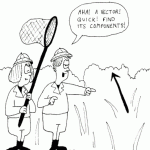Today, I’ll share a little something about Integration by Parts. I want to share this because I observe that several students are over-reliant on the LIATE to perform Integration by Parts. This caused them to overlook/ appreciate its use.
Lets start by reviewing the formula for Integration by Parts
![]()
I like to share with students that Integration by Parts have two interesting facts.
- It allows us to integrate expression that we cannot integrate. Eg.
 or inverse trigonometric functions. This is also closely related to how LIATE is established.
or inverse trigonometric functions. This is also closely related to how LIATE is established. This is closely related to point 1. That is, instead of trying to integrate the expression, we are differentiating it instead. And that itself, is a very important aspect.
Next, I like to point out to students that LIATE is a general rule of thumb.
GENERAL – because it does not work 100% of the times. And today, I’ll use an example to illustrate how LIATE actually fails.
![]()
Here we observe two terms ![]() and
and ![]() . Going by LIATE, we should be differentiating
. Going by LIATE, we should be differentiating ![]() and integrating
and integrating ![]() .
.
![]()
![]()
Now observe what happened here, after applying integration by parts, it got “worst”. We are stuck to integrating ![]() with an exponential… This should raise some question marks. But we did follow LIATE.
with an exponential… This should raise some question marks. But we did follow LIATE.
I’ll leave students to try out this on their own. And feel free to ask questions here. Have fun!


